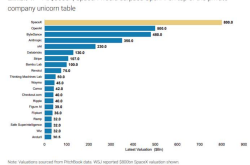August's Smartphone Showdown: High-Performing Budget Phones, Long-Lasting Battery Champs, and Compact Foldables
![]() 08/01 2025
08/01 2025
![]() 572
572
Four new phones, four distinct strategies.
Yesterday (July 30), MediaTek announced that the first batch of 2nm chips will enter trial production in September, anticipated to be the flagship chip for next year. Meanwhile, MediaTek and Qualcomm's new generation of flagship chips for this year are on the horizon, both set to be officially released in September, making the August mobile phone market somewhat subdued.
However, this is relative. In the upcoming August, in addition to the anticipated Meizu 22 and Honor Magic V Flip2, we will also witness the unveiling of the iQOO Z10 Turbo+ and the REDMI Note 15 series. With flagships, foldables, popular mid-range models with minor updates, and main sales models, it can be said that phone manufacturers still have something fresh to offer in August.
Just today, iQOO announced that it will release the new phone iQOO Z10 Turbo+ on August 7 at 19:00. Although this new phone does not belong to the regular all-around flagship series, it is clearly not a "regular upgrade" in terms of configuration, positioning, or topicality.
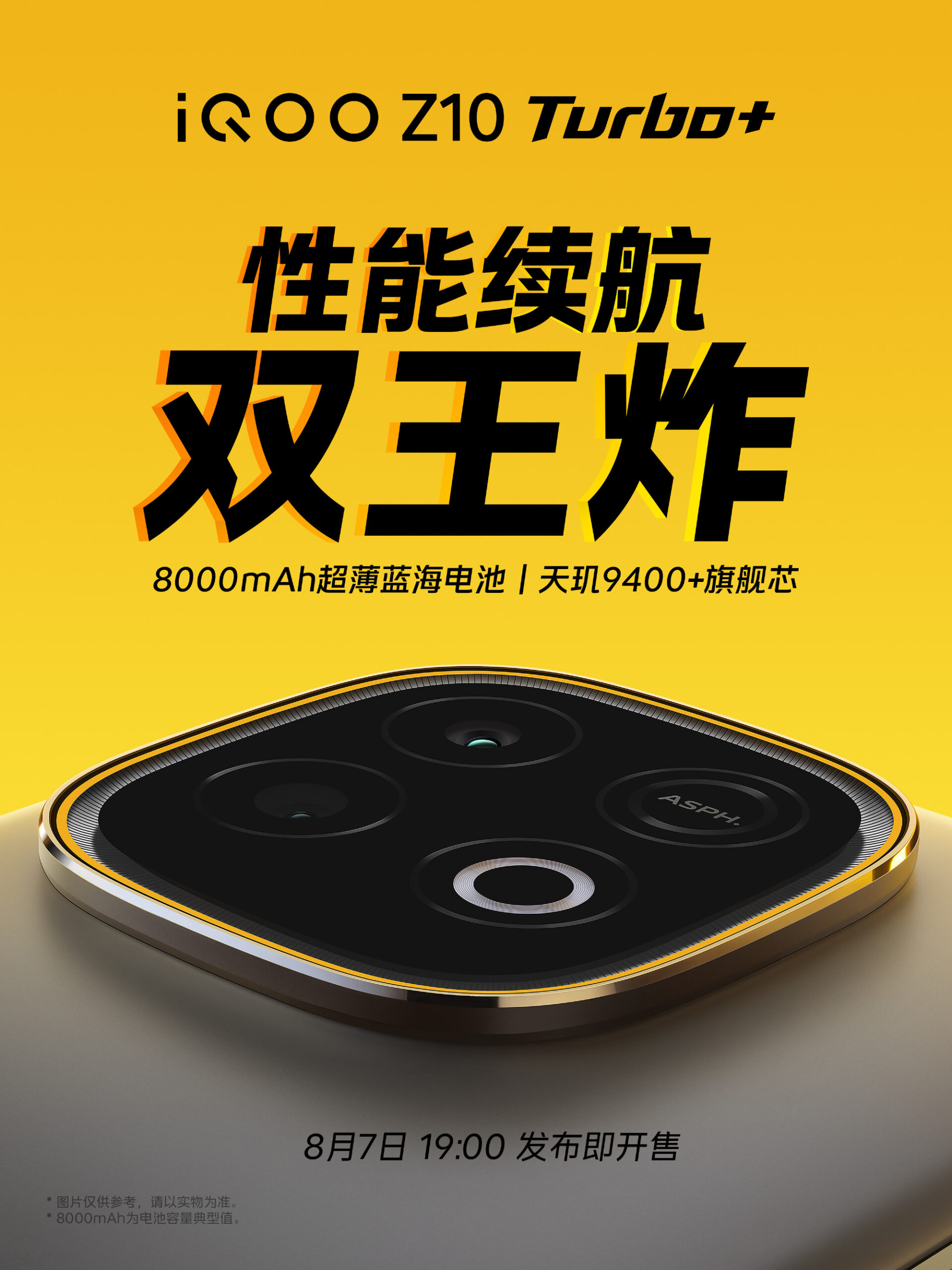
Photo/iQOO
Judging from the information currently revealed by officials and bloggers, the Z10 Turbo+ follows an extreme pragmatism route – not competing on appearance or camera performance, but striving to achieve the ultimate in "performance" and "battery life". One of the core upgrades is that it will be the industry's first performance phone equipped with an 8000mAh ultra-large battery and the Dimensity 9400+ flagship chip.
Before this, although the Honor Power already used an 8000mAh ultra-large battery, it only came with the Snapdragon 7 Gen 3, which was not satisfactory for many gamers. Moreover, for daily practical use, the dual guarantee of performance and battery life can meet the complex needs of more people.
And from the information leaked by officials, the Z10 Turbo+ not only uses the Dimensity 9400+ but also carries the self-developed gaming chip Q2, enabling high frame rate and low power consumption operation in gaming scenarios. Simply put, this combination can drive large mobile games while placing more emphasis on heat control and stability, making it more suitable for heavy gamers to use for extended periods.
In terms of the screen, Xing Cheng, the product manager of the iQOO Z series, has confirmed that the Z10 Turbo+ will be equipped with a Light Field Eye Care Screen, claiming to be the "strongest full-screen brightness among domestic phones" with a peak full-screen brightness of 2000 nits and support for a 144Hz refresh rate. It can be basically confirmed that this screen will be very "eye-catching" under sunlight. However, frankly speaking, this peak parameter greatly exceeds actual needs, and I am actually more concerned about the duration of high brightness under actual outdoor conditions.
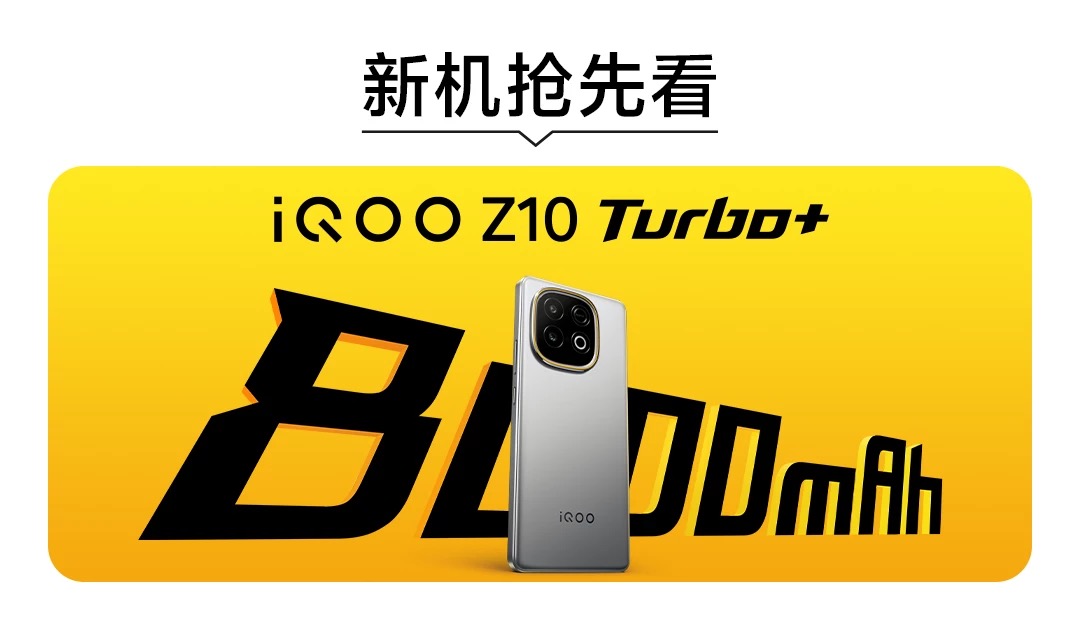
Photo/iQOO
In terms of design, the Z10 Turbo+ does not do much, basically remaining consistent with the previous iQOO Z10 Turbo series, with a body thickness controlled at around 8mm, which is quite impressive for an 8000mAh large battery.
It is worth noting that although it is a product that does not emphasize imaging, the Z10 Turbo+ still retains a practical main camera + ultra-wide-angle dual camera combination. As for the materials of the back and the frame, they remain to be unveiled.
Overall, the Z10 Turbo+ is a product with a very clear positioning. In the words of iQOO officials, it is an "industry's only 8000mAh performance phone", and this sentence, to some extent, summarizes its positioning in the mid-range mobile phone market in August. For users who like long battery life, prioritize gaming experience, and are not too concerned about thinness or imaging flagship features, the Z10 Turbo+ is indeed a new choice worth waiting for.
Although as of press time, the Meizu 22 launch event has not been scheduled, it has been officially announced that it will provide an "experience blind box" for on-site experience at the ChinaJoy exhibition, which opens on August 1. Judging from the promotional rhythm, the official launch event should not be too far away, and is expected to be held in the first half of August.

Photo/Meizu
Compared to other brands, Meizu 22 has taken a different path in product positioning: not bigger or stronger, but smaller, more refined, and more special. Judging from the information currently preheated by officials and bloggers, Meizu 22 has three key selling points – extreme narrow bezels, white panels, and small screen flagship. Looking across the entire Android market, phones of this style are hard to find.
First is the screen. The Meizu 22 features a 6.3-inch straight screen with the world's first four-sided equal-width 1.2mm ultra-narrow bezel and a very rare white front panel. If this data is true, it will break the current record for mobile phone bezel width, going even further than the 1.25mm of the OPPO Find X8s. At the same time, the process difficulty of the white front panel is much higher than that of the black one, requiring not only extremely high-precision bonding but also solving problems such as light leakage and color difference.
Meizu's approach may stem from its persistence in aesthetic sentiment on the one hand, and on the other hand, it aims to create a unique differentiation in the "clustered" small screen flagship market of 2025. In addition, Meizu also emphasized the body width of around 71mm, which can provide an excellent one-handed grip, and with the launch of the "blind feel evaluation" activity, it can be reasonably speculated that Meizu will also have corresponding refinements in corner processing and thickness control, further strengthening the concept of "feel".
In terms of hardware, according to blogger leaks and hints from Meizu executives, the Meizu 22 will be equipped with the Snapdragon 8 Elite flagship chip, and there may also be a version with a higher frequency, but it will definitely use the new generation of flagship chips to be released next month. However, it is certain that according to Xingji Meizu CEO Huang Zhipan, the Meizu 22 will not have a Pro version, but there will be an "ultra-thin Air large screen version" later on.

Photo/Weibo
Even more surprisingly, within the small screen body, the Meizu 22 is likely to pack a large battery of around 5500mAh. If true, it would be on par with the current domestic small screen flagship "battery energy density" level. Coupled with flagship configurations such as 80W wired fast charging, ultrasonic fingerprint recognition, IP68 water resistance, and the new Flyme AIOS system, Meizu obviously hopes that this phone will not only be "good-looking and good-feeling" but can also truly last more than a day as a main phone.
In terms of imaging, although Meizu has not been dominant, this preheating has repeatedly hinted that the Meizu 22 will be equipped with a periscope telephoto lens, forming a triple camera system with a main camera + ultra-wide-angle + periscope. Although the main camera model and algorithm optimization details have not been confirmed yet, it is certain that many Meizu fans also hope that Meizu will no longer lag behind in the imaging experience.
Overall, the Meizu 22 is still a worthwhile attempt, raising the design precision and bringing the user experience to a dimension that is visible and tangible. It may not be a product that is "fierce" in terms of parameters, but it is highly likely to become one of the most distinctive phones in the Android camp this year.
According to leaks from multiple bloggers such as @DigitalChatStation, Honor's new generation of small foldable phone, the Magic V Flip2, will be released in August. And this small foldable may not "compete to the sky" in imaging or performance parameters, but it "hits hard" in another often overlooked dimension – battery life.
Based on the information currently available, the Magic V Flip2 continues the previous generation's vertical folding design, adopting an inner and outer dual-screen solution: the main screen is a 6.8-inch FHD+ LTPO OLED, and the secondary screen is a square high-refresh rate screen of about 4 inches, which can not only display daily information such as notifications, weather, and music but can also be used as a viewfinder for selfies and scanning codes for payment. The overall body maintains a lightweight style, with a volume similar to a card box when folded, easily fitting into daily commutes and women's pockets.
But the biggest highlight this time is battery life. According to leaks, the Magic V Flip2 will be equipped with a large-capacity battery of about 5500mAh, far exceeding the current mainstream small foldables that generally have batteries of just over 4000mAh. It's worth noting that even some previous large foldable flagship phones had configurations below 5500mAh. This means that it may become the small foldable with the best battery life – truly allowing small foldable phones to shed the stereotype of "beautiful but not durable".
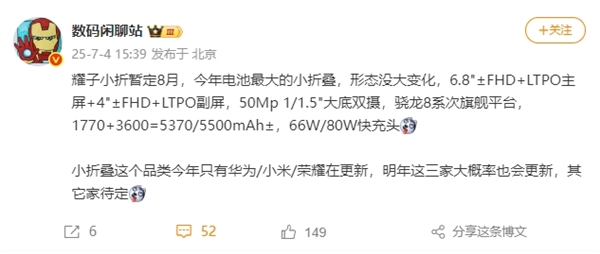
Photo/Weibo
In terms of performance, the Magic V Flip2 is expected to be equipped with the Qualcomm Snapdragon 8s Gen 4 chip, targeting the secondary flagship position, with performance close to the Snapdragon 8 Gen 3, while also having a better energy efficiency ratio, making it particularly suitable for the small foldable structure with limited volume and heat dissipation. Combined with Honor's self-developed power consumption scheduling solution, the daily experience and moderate to heavy gaming performance of the new phone should be above average.
In terms of imaging, the new phone will be equipped with a main camera + ultra-wide-angle dual camera combination, with a 50-megapixel main camera with a sensor size of 1/1.5 inches, which is quite sincere among current small foldables. Although it does not pursue a multi-camera combination or periscope telephoto lens, it can already meet the needs of most users in mainstream scenarios such as selfies, daily photography, and portrait blurring. Especially with the preview function of the outer screen, the composition is more free when taking selfies, and the gameplay is richer.
In short, the Honor Magic V Flip2 is not an all-round "maxed-out" flagship with stuffed specifications, but it has put in a lot of effort in several key areas: first, a large battery combined with fast charging to solve small foldable battery life anxiety; second, a lightweight body + large outer screen to ensure portability and practicality; third, stable performance and decent imaging, making it effortless to use as a main phone. For users who pursue design sense but are unwilling to sacrifice experience for thinness, this may be the "beautiful and capable" choice.
Not long ago, netizens pointed out that the REDMI new phone with model number 2510ERA8BC has obtained network access certification, which is actually the REDMI Note 15 Pro. Judging from the rhythm and leaks, the REDMI Note 15 series will most likely be officially released in August. As REDMI's "main sales" product line, this generation of the Note 15 series is still trying to make the thousand-yuan price range the "benchmark interval for water-tight phones" with stronger configurations and higher completion.
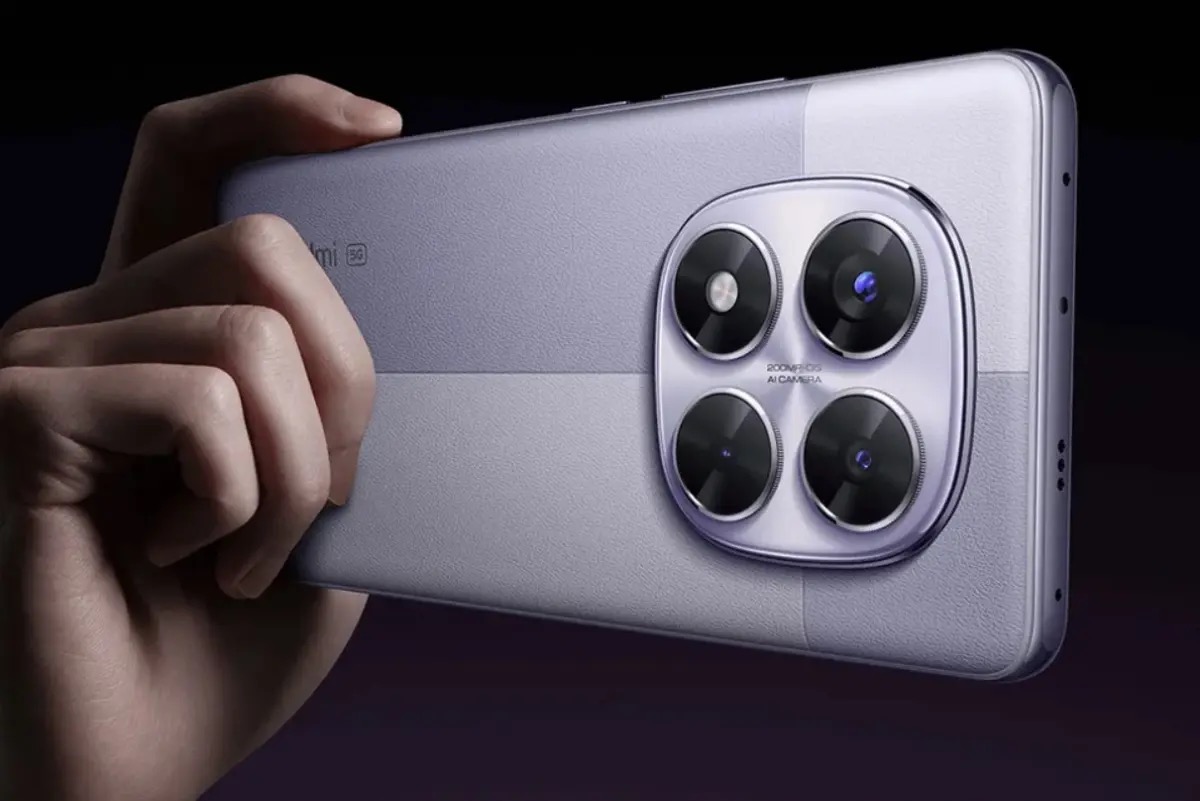
Note 14 series, Photo/ REDMI
Currently, the key models of the REDMI Note 15 series are still the Note 15 Pro and Note 15 Pro+. Both new phones are expected to be equipped with the Qualcomm Snapdragon 7 Gen 4 series chip (or possibly the Snapdragon 7s). In addition to the SoC upgrade, the Note 15 series has also undergone significant evolutions in design and screen this time. The Pro version will adopt an equal-depth micro-curved screen design for the first time, with extremely narrow bezels, and is said to also challenge the "four-sided equal width" level of domestic mid-range phones.
Pursuing flagship quality at the thousand-yuan price point is extremely rare in this price segment. More notably, the Note 15 Pro+ is expected to introduce a 50-megapixel periscope telephoto lens, becoming one of the very few mid-range models at this price point equipped with high-magnification zoom capabilities. Coupled with a large-base main camera and ultra-wide-angle secondary camera, the entire imaging system can be described as a "true triple camera" and is no longer just about quantity. Coupled with the significant leap in water resistance specifications of the previous Note series (supporting IP66/IP68), there are even leaks that it will support IP69 rating, resistant to high-pressure water jets and immersion.
In terms of battery life and charging, the two models do not seem to have introduced silicon-carbon anode technology, with battery capacities expected to be around 5000mAh. The Note 15 Pro is expected to support 45W fast charging, while the Pro+ version is upgraded to 90W fast charging. In addition, there are rumors that the Note 15 Pro+ will also support satellite communication short message functions, further raising the functional upper limit of mid-range phones.
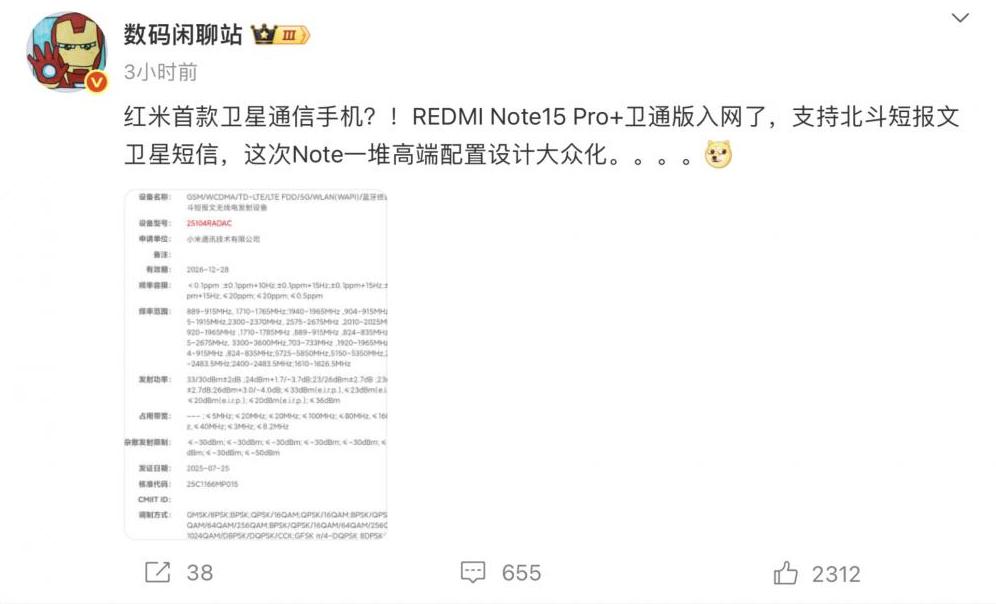
Photo/Weibo
Overall, the product strategy of the REDMI Note 15 series is very clear: through a set of "stuffed" operations in imaging, screen, performance, water resistance, etc., it aims to create a thousand-yuan mid-range segment with a sense of quality and practicality close to that of flagship phones. For users who prioritize the actual experience but have a limited budget, this is still the "king of competition" series that "is not afraid to compare configurations with you".
Upon examining these four upcoming August smartphones, an intriguing pattern emerges: despite stemming from diverse brands and targeting varying price points, they unanimously emphasize "differentiation." Whether through extreme specifications or unique designs, each seeks to establish a defining feature within its respective price bracket.
The iQOO Z10 Turbo+ stands as a pragmatic icon, marrying an 8000mAh battery with the Dimensity 9400+ chip to deliver a robust device tailored for heavy usage. Conversely, the Honor Magic V Flip2 opts for a "battery life counteroffensive," spotlighting the formidable battery and heat management challenges within a compact foldable design, boasting a 5500mAh capacity that's virtually unmatched in its class.
Among the quartet, the Meizu 22 exhibits the most distinct personality. It evokes nostalgia among loyal fans with its ultra-narrow white bezel, 6.3-inch screen, and unique aesthetic. Additionally, it addresses previous shortcomings by incorporating a periscope telephoto lens, flagship chip, and IP68 rating, aiming to reinvigorate the brand's high-end presence. However, Meizu confronts two significant hurdles: the impending replacement of flagship chips and the need to revitalize brand influence.

Photo/Meizu
The Redmi Note 15 series continues to dominate the mid-range segment, priced around 1,000 yuan. Features like periscope telephoto lenses, equal-depth micro-curved screens, high protection ratings, and satellite communication persist, pushing the boundaries of what a comprehensive smartphone can offer. While it boasts solid specifications, competitors are also stepping up their game. Maintaining its reputation as a "superb budget phone" hinges on the final price and user experience.
Four phones, four strategies, united by their commitment to addressing the increasingly segmented and diverse needs of consumers. This landscape, which transcends the sole focus on performance benchmarks or camera sensors, promises much excitement. August's mobile phone market may lack an absolute "king," but it certainly doesn't lack "individual brilliance." Which of these devices piques your interest the most?
Source: Leitech
Images in this article are from: 123RF Authenticated Image Library. Source: Leitech

